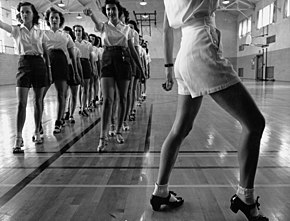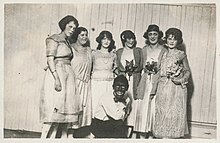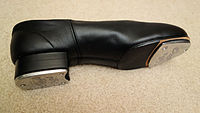Tap dance

Tap dance(ortap) is a form of dance that uses the sounds oftap shoesstriking the floor as a form of percussion; it is often accompanied by music.[1]Tap dancing can also bea cappella,with no musical accompaniment; the sound of the taps is its own music.
It is an African-American artform that evolved alongside the advent of jazz music.[2][3]Tap is a type ofstep dancethat began with the combination ofSouthern AmericanandIrish dancetraditions, such asIrish soft-shoe and hard-shoe step dances,[4]and a variety of bothslaveand freeman step dances. The fusion of African rhythms and performance styles with European techniques of footwork led to the creation of tap dance.[5]This fusion began in the mid-17th century but did not become popular until the mid-19th century.[6]
There are two major versions of tap dance: rhythm (jazz) tap and Broadway tap. Broadway tap focuses on dance; it is widely performed inmusical theater.Rhythm tap focuses onmusicality,and practitioners consider themselves to be a part of thejazztradition.
The sound is made by shoes that have a metal "tap" on the heel and toe. Different shoes may differ in their sound.
History
[edit]

Tap dance is an indigenous American dance form with roots that go back 300 years toIrishandWest Africanmusical andstep dancetraditions. During the 17th – 19th centuries, it was primarily developed from European step dance forms, such asjigsandclogs.[7]These dances were brought to America by immigrants and eventually grew to incorporateAfrican rhythms and styles.These fused and evolved into a form of dance called "jigging", which was taken up byminstrel showdancers in the 1800s. Tap dance then became a popular stage entertainment.[8]
As minstrel shows began to decline in popularity, tap dance moved to the increasingly popularVaudevillestage. Due to Vaudeville's unspoken "two-colored rule", which forbade blacks to perform solo, many Vaudeville tap acts were duets.[9]One such duo was "Buck and Bubbles," which consisted ofJohn "Bubbles" Subletttap dancing and Ford "Buck" Washington playing a piano. The duo performed a "Class Act", a routine in which the performers wore tuxedos, effectively distinguishing them from the older minstrel show concept of tap dancers as "grinning-and-dancing clowns."[10]
Another notable figure during this period isBill "Bojangles" Robinson,a protégé ofAlice WhitmanofThe Whitman Sistersaround 1904 (then known as "Willie Robinson" ).[11]Well versed in bothBuck and Wingdancing and Irish Step dancing, Robinson joined the Vaudeville circuit in 1902 in a duo with George W. Cooper. The act quickly became famous, headlining events across the country, and touring England as well. In 1908, the partnership ended and Robinson began dancing solo, which was extremely rare for a black man at that time.[12]Despite this, he had tremendous success and soon became a world-famous celebrity.[9]He went on to have a leading role in many films, notably in theShirley Templefranchise.
Shortly thereafter, theNicholas Brotherscame on the scene. Consisting of real life brothers Fayard and Harold, this team wowed audiences with their acrobatic feats incorporated into their classy style of dancing. A notable scene in the movie "Stormy Weather" features the pair dancing up a staircase and then descending the staircase in a series of leapfrogs over each other into a full split from which they rise with no hands.[13]"Stormy Weather" was a six-minute performance performed in one go with no retakes. TheNicholas Brothersdanced on pianos and many other structures during this performance.[13]
During the 1930s, tap dance mixed withLindy Hop."Flying swing outs" and "flying circles" are Lindy Hop moves with tap footwork. In the mid-to-late 1950s, the style of entertainment changed. Jazz music and tap dance declined, while rock and roll and the newjazz danceemerged. What is now calledjazz danceevolved out oftap dance,so both dances have many moves in common. But jazz evolved separately from tap dance to become a new form in its own right. Well known dancers during the 1960s and 1970s includedArthur DuncanandTommy Tune.[citation needed]
No Maps on My Taps,the Emmy award winning PBS documentary of 1979, helped begin the recent revival of tap dance. The outstanding success of theanimated film,Happy Feet,has further reinforced the popular appeal.[14]National Tap Dance Dayin the United States, now celebrated May 25, was signed into law by President George Bush on November 7, 1989. (May 25 was chosen because it is the birthday of famous tapperBill "Bojangles" Robinson.) Prominent modern tap dancers have includedSarah Reich,Brenda Bufalino,Melinda Sullivan,The Clark Brothers,James "Buster" Brown,Savion Glover,GregoryandMaurice Hines,LaVaughn Robinson,Jason Samuels Smith,Chloe Arnold,Michelle Dorrance,Dormeshia Sumbry-Edwards,andDianne "Lady Di" Walker.Indie-popbandTilly and the Wallalso features a tap dancer, Jamie Pressnall, tapping as percussion.
Segregation's impact
[edit]
During the 1930s and the 1940s, Americans were able to watch tap dancers perform on film.[15]However, Black tap dancers found it difficult to be a part of these White films becausesegregationwas prominent in America.[15]This led to the creation of two different styles of tap dance: White tap dancers formed a Broadway style and Black dancers continued to evolve with the traditional rhythm based style.[15]Broadway tap dance was performed in mainly Broadway musicals and film, and it did not emphasize classic jazz rhythms.[15]Rhythm tap integrated more of the classic African roots of tap dance, and it emphasized jazz rhythms, musicality, and improvisation.[15]Musicalityis the dancer's understanding of the music they are performing to. Improvisation is where a dancer makes up the movement as they perform, and the choreography is not prepared beforehand.
There was also the "two-color rule," which made sure that black tap dancers were not able to perform solos onstage.[16]This led to some tap dancers performing comedic tap duets. There were stereotypes placed on black Americans such as the "Uncle Tom" stereotype, and many tap dancers were forced to wear "black-face"onstage to perform.[16]One of the first black tap dancers to be acknowledged by America wasBill "Bojangles" Robinson,who performed duets withShirley Temple.[16]However, Bill Robinson's career was reduced to "minstrelsy," which can be defined as White performers using makeup to mock black culture or using black stereotypes in a performance.[17]Black Americans joined theseminstrelperformances, where they would be forced to act on black stereotypes in their performances.[17]James "Buster" Brown,got his start in the segregated clubs of the 1930s, but eventually earned international mainstream recognition and mentored younger more modern tap dancers in the 1990s.[18]
Characteristics
[edit]This sectionneeds additional citations forverification.(October 2023) |

Tap dancers make frequent use ofsyncopation.Choreography typically starts on the eighth or firstbeatcount. Another aspect of tap dancing isimprovisation.Tap dancing can either be done with music following the beats provided, or without musical accompaniment; the latter is known as "a cappella"tap dancing.
Hoofers are tap dancers who dance primarily "closer to the floor", using mostly footwork and not showing very much arm or body movement.[19]This kind of tap dancing, also calledrhythm tap,was employed by slaves in America.[20]
Steve Condosdeveloped an innovative rhythmic tap style that influenced the work of later tap dancers such asGregory HinesandSavion Glover.The majority of early hoofers, such asSammy Davis Jr.,Glover, Hines, andLaVaughn Robinsonwere African American men.[20]Savion Gloverhelped bring tap dance into mainstream media by choreographingHappy Feet,a film about a tap dancing penguin. Another well-known tap film is 1989'sTap,starring Gregory Hines and many old-time hoofers.
Early tappers likeFred Astaireprovided a moreballroomlook to tap dancing, whileGene Kellyintroduced ballet elements and style into tap. This style of tap led to what is today known asBroadway style,which is popular in American culture. It often involves high heeled tap shoes and show music, and is usually the type of tap first taught to beginners. Examples of this style are found in Broadway musicals such asAnything Goesand42nd Street.
"Soft-Shoe" is a rhythm form of tap dancing that does not require special shoes, and though rhythm is generated by tapping of the feet, it also uses sliding of the feet (even sometimes using scattered sand on the stage to enhance the sound of sliding feet) more often than modern rhythm tap. It preceded what is currently considered to be modern tap, but has since declined in popularity.[21]
Tap Steps
[edit]Basic tap steps are known as "one-sound steps" and are either weight shifting or non-weight-shifting steps. Common basic tap steps include heel drops, toe drops, a brush, scuff, chug, pull, hop, leap and step.[1]
In advanced tap dancing, basic steps are often combined together to create new steps. Many steps also have single, double, and triple variations, or can have a variation with a pickup, which is essentially adding an additional brush sound. Popular steps with many variations include pullbacks, timesteps, riffs,[22]and drawbacks.
Time steps is an umbrella term that is widely used in tap for any combination of steps that follows a specific rhythm or pattern. These consist of a rhythm that is changed to make new time steps by adding or removing steps. There are many variations of the basic time step, including the single, double, and triple time steps. Time steps consist of single- and multi-sound step combinations.[1]
In tap, various types of turns can be done, including step heel turns, Maxi Ford turns, cramp-roll turns, and drag turns. All tap turns can be practiced in both directions.[1]
Other common tap steps include the shuffle, shuffle ball change, double shuffle, leap shuffle, flap, flap ball change, running flaps, flap heel, cramp-roll, buffalo, Maxi Ford, Maxi Ford with a pullback, pullbacks, wings, Cincinnati, the shim sham shimmy (also called the Lindy), Irish, Waltz Clog, the paddle roll, the paradiddle, stomp, brushes, scuffs, spanks, single and double toe punches, hot steps, heel clicks toe stands, over-the-tops, military time step, New Yorkers, and Shiggy Bops.
Tap shoes
[edit]
In the earliest years of tap dancing, tap shoes often had wooden soles.[23]The soles of modern tap shoes are either full-sole or split-sole. A full-sole tap shoe has a continuous base material along the underside of the shoes; a split-sole tap shoe has a gap in the base material under the arch of the foot, making them more flexible. Modern tap shoes have soles with heels of varying height (one inch or more) and are commonly made of wood or stacked leather.[24]Some beginner tap shoes have heels made of plastic.[25]The toe box of the tap shoe is located on the front of the shoe for the purpose of reinforcing the shoe; however there are tap shoes that use a soft leather instead.[25]A single tap shoe has two taps: one under the heel, and another under the toes.[24]
Popular tap shoe makers includeBlochandCapezio.
Styles
[edit]There are several styles of tap shoes:[26]
- Mary Jane
- Character Heel
- Oxford
Taps
[edit]Depending on manufacturer and model, tap characteristics can vary considerably. For example, some taps have relatively low weight and small footprint whereas others may be thicker and fill out the edge of the shoe more, making them heavier as a result. A tap's "tone" is influenced by its weight as well as its surface shape, which may be concave or convex.[27]The tonal quality of a tap can also be influenced by the material it is made from, and the presence of a soundboard.
-
Side view of tap shoe, showing taps mounted to bottoms of heel and toe
-
Metal tap on bottom of heel
-
Metal tap on bottom of toe
Taps are mounted to the sole of the shoe with screws, and sometimes adhesive as well. The screws are driven into asoundboard– a thin fiberboard integrated into the sole that can be firmly "gripped" by the screws – to reliably attach the tap to the shoe. When no adhesive is used, the screws can be loosened or tightened to produce different sounds, whereas tonal quality is fixed when adhesive is used.[citation needed]
See also
[edit]References
[edit]- ^abcdMichiels Hernandez, Barbara L.; Ozmun, Michelle; Keeton, Gladys (April 2013)."Healthy and Creative Tap Dance: Teaching a Lifetime Physical Activity".Journal of Physical Education, Recreation & Dance.84(4): 29–40.doi:10.1080/07303084.2013.773810.ISSN0730-3084.S2CID144368244.
- ^"A Brief Overview of the Origins and Evolution of Tap Dance".20 March 2023.
- ^https:// masterclass /articles/tap-dance-guide
- ^"Home - Irish Dancing Magazine".
- ^Sommer, Sally R. (1998),"Tap Dance",in Cohen, Selma Jeanne (ed.),The International Encyclopedia of Dance,Oxford University Press,doi:10.1093/acref/9780195173697.001.0001,ISBN978-0-19-517369-7,retrieved2023-10-31
- ^Craine, Debra; Mackrell, Judith (2010-01-01),"tap dancing",The Oxford Dictionary of Dance,Oxford University Press,doi:10.1093/acref/9780199563449.001.0001,ISBN978-0-19-956344-9,retrieved2023-10-31
- ^Blume, Julie (2023-03-20)."A Brief Overview of the Origins and Evolution of Tap Dance".LiveTheDance is a dance blog – Guides, Reviews, Tips for Dancers.Retrieved2024-06-27.
- ^"Tap Dance in America: A Short History".Library of Congress, Washington, D.C. 20540 USA.Retrieved2022-10-20.
- ^abGates, Henry Louis. "Harlem Renaissance lives from the African American national biography." Oxford University Press, 2009, pg. 429.
- ^"The Class Act – Pete, Peaches & Duke – Coles & Atkins".American Tap Dance Foundation.Archived fromthe originalon 2010-06-16.
- ^Thomas F DeFrantz (April 1, 2002).Dancing Many Drums: Excavations In African American Dance.Univ of Wisconsin Press.ISBN9780299173135.
- ^David Hinkley, Gregory Hines (February 4, 2001)."HERE'S TO YOU, MR. ROBINSON".The Daily News.
- ^abVideoonYouTube
- ^Sarah Kaufman (December 17, 2006)."Tapping a Gold Mine of Motion".Washington Post.RetrievedDecember 16,2007.
- ^abcde"Tap Dance in America: A Short History".Library of Congress, Washington, D.C. 20540 USA.Retrieved2022-11-29.
- ^abc"'Bojangles' salutes tap dancer who broke race barriers ".Christian Science Monitor.2001-02-02.ISSN0882-7729.Retrieved2022-11-28.
- ^abDURKIN, HANNAH (2010).""TAP DANCING ON THE RACIAL BOUNDARY": RACIAL REPRESENTATION AND ARTISTIC EXPERIMENTATION IN BILL "BOJANGLES" ROBINSON'S STORMY WEATHER PERFORMANCE ".IJAS Online(2): 98–106.ISSN2009-2377.JSTOR26234258.
- ^Hill, Constance Valis (2014).Tap Dancing America: A Cultural History.Oxford University Press. p. 103.ISBN978-0-19-022538-4.RetrievedFebruary 2,2024.
- ^Valis Hill, Constantine (2010).Tap Dancing America.Oxford University Press.p. 388.ISBN978-0-19-539082-7."Hoofer, a tap dancer who emphasizes movements from the waist down, and concentrates on the flat-footed percussive intricacies of the feet"
- ^abEdwards, Mary (2020)."Jamie A. Thomas and Christina Jackson (editors), Embodied Difference: Divergent Bodies in Public Discourse. Lanham, Md.: Le xing ton Books, 2019 (ISBN: 978-1-4985-6386-4)".Hypatia Reviews Online.2020.doi:10.1017/s2753906700003338.ISSN2753-9067.
- ^A Brief History of the Soft Shoes Dancethemovingarts
- ^Silao, Nia (2021-07-03)."RIFFS: A Theory of Instruction and Reference for Step Progression in Tap Dance".Dance Education in Practice.7(3): 6–17.doi:10.1080/23734833.2021.1954852.ISSN2373-4833.S2CID237548320.
- ^The Origin Of Tap Dance, Beholders.org, 12 Sept 2011
- ^ab"Tap Shoe Guide | Bloch US".BLOCH Dance US.2022-04-25.Retrieved2023-10-30.
- ^ab"Anatomy of a tap shoe".abbystandingtap.2016-12-28.Retrieved2023-10-31.
- ^Bellerose, Author Samantha (2021-09-12)."How to Choose the Right Shoes for Tap Dance Classes?".Retrieved2023-11-24.
{{cite web}}:|first=has generic name (help) - ^"Customizing Your Tap Shoes: The Taps".Dance Advantage. 2011-07-05.Retrieved2013-02-25.
Further reading
[edit]- Ames, Jerry; Siegelman, Jim (1977).The Book of Tap: Recovering America's Long Lost Dance.David McKay Company.ISBN0679506152.OCLC2493445.
- Seibert, Brian (2015).What the Eye Hears: A History of Tap Dancing.New York: Farrar, Straus and Giroux.ISBN9781429947619.OCLC898419561.
External links
[edit]- The Origin of Tap Danceat beholders.org
- All About Tap Danceat TheatreDance
- Tap danceatCurlie
- Interview with Donald O'Connor on the history of tap dancing
- Archival footage of Dianne Walker, Derick K. Grant, and Constance Vallis Hill inPillowTalks: Tap Dancing in Americaat Jacob's Pillow, 7/1/2010
- Tap dance dictionary
- "The Black History of Tap Dancing"—Afropop Worldwide,1 December 2022




